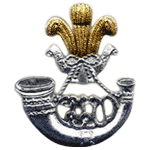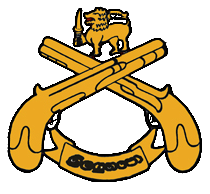
In military organizations, a colour guard is a detachment of soldiers assigned to the protection of regimental colours and the national flag. This duty is highly prestigious, and the military colour is generally carried by a young officer (ensign), while experienced non-commissioned officers are assigned to the protection of the national flag. These non-commissioned officers, accompanied sometimes by warrant officers, can be ceremonially armed with either sabres or rifles to protect the colour. Colour guards are generally dismounted, but there are also mounted colour guard formations as well.
The hackle is a clipped plume or short spray of coloured feathers that is attached to a military headdress, with different colours being associated with particular regiments.

In military organizations, the practice of carrying colours, standards, flags, or guidons, both to act as a rallying point for troops and to mark the location of the commander, is thought to have originated in Ancient Egypt some 5,000 years ago. The Roman Empire also made battle standards, reading SPQR a part of their vast armies. It was formalized in the armies of Europe in the High Middle Ages, with standards being emblazoned with the commander's coat of arms.

The Queen's Truncheon is a ceremonial staff carried by the Royal Gurkha Rifles that serves as the equivalent of and is carried as the Colour. It is made of bronze and silver. The top represents the minaret of Delhi Palace with three Gurkhas standing on it supporting the Queen's crown above their heads. The minaret contains a pair of crossed kukris and carries the inscription "Main Picqet Hindoo Rao's House, Delhi 1857". The Truncheon is a unique emblem upon which recruits swear allegiance to the Regiment and the Crown.

A battle honour is an award of a right by a government or sovereign to a military unit to emblazon the name of a battle or operation on its flags ("colours"), uniforms or other accessories where ornamentation is possible.

The Regulation Colours are the standard colours used in the armed forces of the countries of the Commonwealth of Nations.

A rifle regiment is a military unit consisting of a regiment of infantry troops armed with rifles and known as riflemen. While all infantry units in modern armies are typically armed with rifled weapons the term is still used to denote regiments that follow the distinct traditions that differentiated them from other infantry units.

The Sri Lanka Army is the oldest and largest of the Sri Lanka Armed Forces. Established as the Ceylon Army in 1949, it was renamed when Sri Lanka became a republic in 1972. In 2010, the Army had approximately 200,000 regular personnel, between 20,000 and 40,000 reserve (volunteer) personnel and 18,000 National Guardsmen and comprises 13 divisions, one air-mobile brigade, one commando brigade, one special forces brigade, one independent armored brigade, three mechanized infantry brigades and over 40 infantry brigades.

Gorget patches are an insignia in the form of paired patches of cloth or metal on the collar of a uniform (gorget), used in the military and civil service in some countries. Collar tabs sign the military rank, the rank of civil service, the military unit, the office (department) or the branch of the armed forces and the arm of service.

The Sri Lanka Light Infantry (SLLI) is the oldest regiment in the Sri Lanka Army and the oldest infantry regiment in the army. It is made up of ten regular battalions and five volunteer battalions, and is headquartered at the Panagoda Cantonment, Panagoda. Over the years it has become the most distinguished and dependable regiment in the army.

The Sri Lanka Sinha Regiment (SLSR) is an infantry regiment of the Sri Lanka Army; it is the second oldest infantry regiment in the army. It is made up of seven regular battalions, five volunteer battalions and a headquarters battalion at the Ambepussa Camp.

The Sri Lanka Air Force Regiment is a specialized ground combat corps within the Sri Lanka Air Force, responsible for capturing and defending airfields and associated installations. Its members are the SLAF Regiment Officers and the airmen of operations ground specialization. The SLAF Regiment is fully capable of protecting all its air bases, installations by itself using infantry and light armored units as well as launch air assaults with Airborne Infantry elements (paratroopers). Ground-based air defense of vital military and civil installations around the country is carried out by the SLAF Regiment along with combat search and rescue missions (CSAR). The corps itself is simply known as the 'regiment'.

The Sri Lanka Corps of Military Police (SLCMP) is the branch of the Sri Lanka Army responsible for the policing of service personnel and providing a military police presence on service property, operations and exercises. It is made up of three regular regiments and with headquartered at Regiment Center Polhengoda, Colombo. Like other military police around the world, they continue to wear white webbing with barrack dress but white gaiters.

General Ganegoda Appuhamelage Don Granville Nalin Seneviratne, VSV was a Sri Lankan Army general. He was the Commander of the Sri Lankan Army from 1985 to 1988 and first Governor of the North East Province.
65th Armoured Regiment, is an armoured regiment which is part of the Armoured Corps of the Indian Army.

Field marshal (FM) is the five-star rank of the Sri Lanka Army and ranks immediately above general. the rank has been awarded only once, to Sarath Fonseka as an honorary rank. It is equivalent to admiral of the fleet and marshal of the Sri Lanka Air Force.

The uniforms of the Sri Lanka Army currently exist in several categories ranging from ceremonial uniforms to combat dress.

The Presentation of Colours is a ceremony that marks an anniversary or event in the history of a particular regiment. This involves the presentation of a new version of the regimental colour to a regiment or equivalent formation in the armed forces. This is a traditional ceremony that was pioneered by the British Armed Forces, and is today used in most Commonwealth countries.

Colonel (Col) is a senior officer rank in the Sri Lanka Army that is a superior rank to lieutenant colonel and subordinate to Brigadier. The rank has a NATO rank code of OF-5, equivalent to captain in the Sri Lanka Navy and group captain in the Sri Lanka Air Force.
The President's Rana Parashuwa and the Regimental Rana Parashuwa are ceremonial hatchets carried by the Special Forces Regiment that serves as the equivalent of and is carried as the colours.















